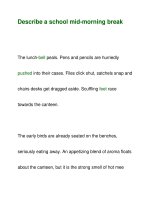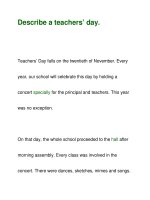Describe a famous food from your hometown or country
Bạn đang xem bản rút gọn của tài liệu. Xem và tải ngay bản đầy đủ của tài liệu tại đây (79.57 KB, 3 trang )
Describe a famous food from your hometown or country.
You should say: For example, the most popular food, “pho” is made from many elements, which
offer all necessary nutrients for a regular meal: carbohydrate and calories from noodle, protein
added by beef or chicken, fat from broth (well cooked with bones, pork and beef) and vitamins from
onions, chili and herbs.
Y
• what it is
• what it tastes like
• how it is prepared
and explain why this is famous food.
When it comes to Vietnamese foods, the first food that crosses most people’s mind is definitely Pho,
or Vietnamese rice noodle. In fact, this dish has long been listed as one of the most delicious foods
in the world and has found its place on the world’s culinary map. So, naturally, I would like to talk
about this most famous dish in my country.
Actually, Pho is not that difficult to cook and it doesn’t take a professional chef with years of
experience to make a perfect bowl of Pho. The trickiest part of making this food, though, is to find
all the spices and ingredients, which, if you don’t live in Vietnam or a Vietnamese community,
could be an impossible mission and you would just have to go ahead and do without some of the
herbs or spices.
The very first step of cooking Pho is to make the broth by boiling knuckle bones or leg bones. Then,
you can add thin rice noodles and either chicken or beef to the boiling broth together with some
condiments according to your taste. That’s basically it. Before you enjoy the pho, just add some
slices of chilly and a few lime drops to increase the tastiness. Pho is best when its served hot with
fresh mint, basil and bean sprouts.
I think the reason behind the popularity of this dish lies in its simplicity yet tastiness. It’s easy to
make, easy to enjoy and hard to forget. If you give this Asian food a try, you’ll most likely find
yourself craving more and more of it.
5/ Banh mi – Vietnamese baguette Sandwich
Commonly well-known along with Pho, Vietnamese baguette sandwiches, called Banh Mi, have
attracted a growing fan base around the word. The uniqueness of Banh mi not only lies within the
light and crispy baguette, but also the variation of flavors Vietnam fillings bring out the most
amazing flavor.
This baguette sandwich filled with greens and a choice of fillings, including pâté and freshly made
omelet, is so delicious that it’s been imitated around the world. In the north chefs stick to the basic
elements of carbohydrate, fat and protein—bread, margarine and pate—but head south and your
banh mi may contain a more colorful combination of cheese, cold cuts, pickled vegetables, sausage,
fried egg, fresh cilantro and chili sauce.
Be prepared for long waiting lines of this popular Banh Mi store for both locals and tourists.
Vietnamese food, in general, is the collection of various elements. Both in a single dish or the whole
meal, Vietnamese food is served with usually many substances mixed together, rarely one element.
And this method creates healthy meals for consumers, since all the nutritious substances needed are
provided with dishes. For example, the most popular food, “pho” is made from many elements,
which offer all necessary nutrients for a regular meal: carbohydrate and calories from noodle,
protein added by beef or chicken, fat from broth (well cooked with bones, pork and beef) and
vitamins from onions, chili and herbs. That is the reason why “pho” is favored by many Vietnamese
for breakfast. Just a simple bowl, but could generate enough energy for a whole morning.
Another characteristic of Vietnamese food is less fat, more vegetables. The majority of the local,
especially the elderly, do not like meat lover dishes like beef steak or ribs, too much protein and fat.
Vietnamese prefer stuffs with many vegetable in it, like salad or soup. But, it does not mean that
Vietnamese food has no meat-element. Mainly vegetable, but with some meat added, Vietnamese
foods still offer enough nutrients, but are not too much calories like some Western dishes. For
example, chicken salad contains cucumbers, lettuce, onion, chili, sesame, peanut, mint, garlic,
lemon drop but still has sliced chicken and fish sauce. Likewise, vegetable soups are usually cooked
with pork, meat balls, beef, crab or shrimp. This wise method creates a very unique taste for the
food as well with a sensible rate of nutrition. More over, Vietnamese often boil, simmer or stir-fry
the food, rarely deep fry or roast them. And all the deep fry stuffs (with much oil and fat) are served
with many kinds of vegetable: sliced morning star, lettuce, basil, cilantro, bean sprout and etc in
order to reduce the greasiness of the dishes.
In term of the whole meal, Vietnamese also focus on the fine combination of essential nutrients. The
regular meal always has a staple food, usually rice (sometimes rice is replaced with noodle,
vermicelli, gruel, bun or bread...) go with one or two main dishes (pork, fish, beef, crab, shrimp or
egg). Another regular food is vegetable, which rarely misses from Vietnamese meal. Vegetable is
usually boiled, stir-fried or cooked as soup. Whichever way it is served, vegetable is very important
with Vietnamese, like a phrase “Meal without vegetable like disease without treatment”
(Vietnamese: An khong rau nhu dau khong thuoc). The last thing in the meal is a bowl of soup (can
be skipped if vegetable represents in soup already). The soup can be quite well-cooked, like sour
soup (canh chua) or just simply vegetable boiled water to add vitamins and water needed for a day.
Thus far, the meal can supply a fine proportion of nutrients for consumers, in which no element
(carbohydrate, protein, fat, and vitamins) is absent. Nevertheless, the way Vietnamese people eat
also guarantees a sensible nutrition rate for them. They rarely eat just a kind of food, like only meat
or only vegetable. They always carefully mix the food together for their bowl, in order to balance
the amount of nutrients. This forms a healthy eating habit for Vietnamese and varies their inherently
special gastronomy.
Sydney is my favourite city among the cities I have visited so far. Sydney is the state capital of New
South Wales of Australia. This city is situated on the bank of Tasman Sea and has around 4.6
million people. I have visited this city in 2008 after I finished my graduation and loved my stay
there. Sydney had many attractive natural areas, botanic gardens, parks, and high rising buildings.
This city has many heritage listed buildings that attract the tourists and visitors. The Sydney Opera
House is one of the most recognised landmarks in Australia and is a great place to visit.
This city is known for the dynamic cultural hub and it has many famous museums, galleries and art
galleries as well. Because of the great architecture, warm weather and hundreds of tourists attraction
more than 11 million international and domestic tourists visit this city each year. I had been there
for about 15 days and I really enjoyed everything about this city. I stayed at a 20 storied hotel that
offered a really amusing sight views. The transportation system of the city is better than many other
cities and I could have been maintaining the track and time of my schedule because of that. I loved
being at open & wide spaces in the gardens and parks. People are welcoming and friendly there. A
tourist can get necessary help both from people and the authority and can roam easily without any
interruption. I saw 2/3 art museum and some cultural festivals and those were awesome.
There are so many places to be, so many things to do in Sydney. Some of the attractive places are
Royal Botanic Garden, Hyde Park, Queen Victoria Building, Sydney Town hall, Macquarie
Lighthouse, Australia Square, Sydney Opera House and so on.
I had a tremendous vacation in Sydney and I liked most of the places there and I enjoyed so much
that I did not even notice how quickly the 2 weeks scheduled time has passed.
Describe the process of getting a job in your country?
In my country, different jobs have different procedure. However, in general, if we talk about some
corporate or government job, one has to first pass a written test, followed by an interview. In other
jobs, there are mostly, few rounds of interviews before someone is hired. On hiring background and
criminal records are checked, after which the person is kept on the job.
ntroduction
When you are looking for a job there is a range of information sources and supports to help you in
your search. You may looking for a job for the first time after leaving school or college or you may
be thinking of changing job or returning to work. If you are unemployed, there are a number of
services and supports to help you find work – see below. Whether you are currently in work,
unemployed or in education, the process of finding and applying for a job is the same. It is
important to research all possible sources of information on employment opportunities, to send in a
well-prepared job application with a relevant CV (curriculum vitae) and, if your application is not
successful, to continue the search for employment. Alternatively you should also look at other
options such as returning to education or self-employment. If you are coming from outside Ireland
to work you can find more information in our document, Finding a job in Ireland.
Applying for a job
Your CV or resumé is a very important document. It is a summary of your personal details,
educational qualifications and work experience. It should also include your key skills and other
relevant information together with the names of 2 people who will provide a reference for you.
When you identify a job vacancy, contact the employer to get further details about it and the
company. You should update your CV and send it with a letter or application form as specified in
the job advertisement. The information in your CV and application letter or form should focus on
the specific requirements of the job. If you are called for a job interview it is important to prepare
for it.
If you are unemployed, your local employment service (LES) or Job Club can assist you with
writing CVs and job applications and with training in interview skills – see ‘Other supports’ below.









